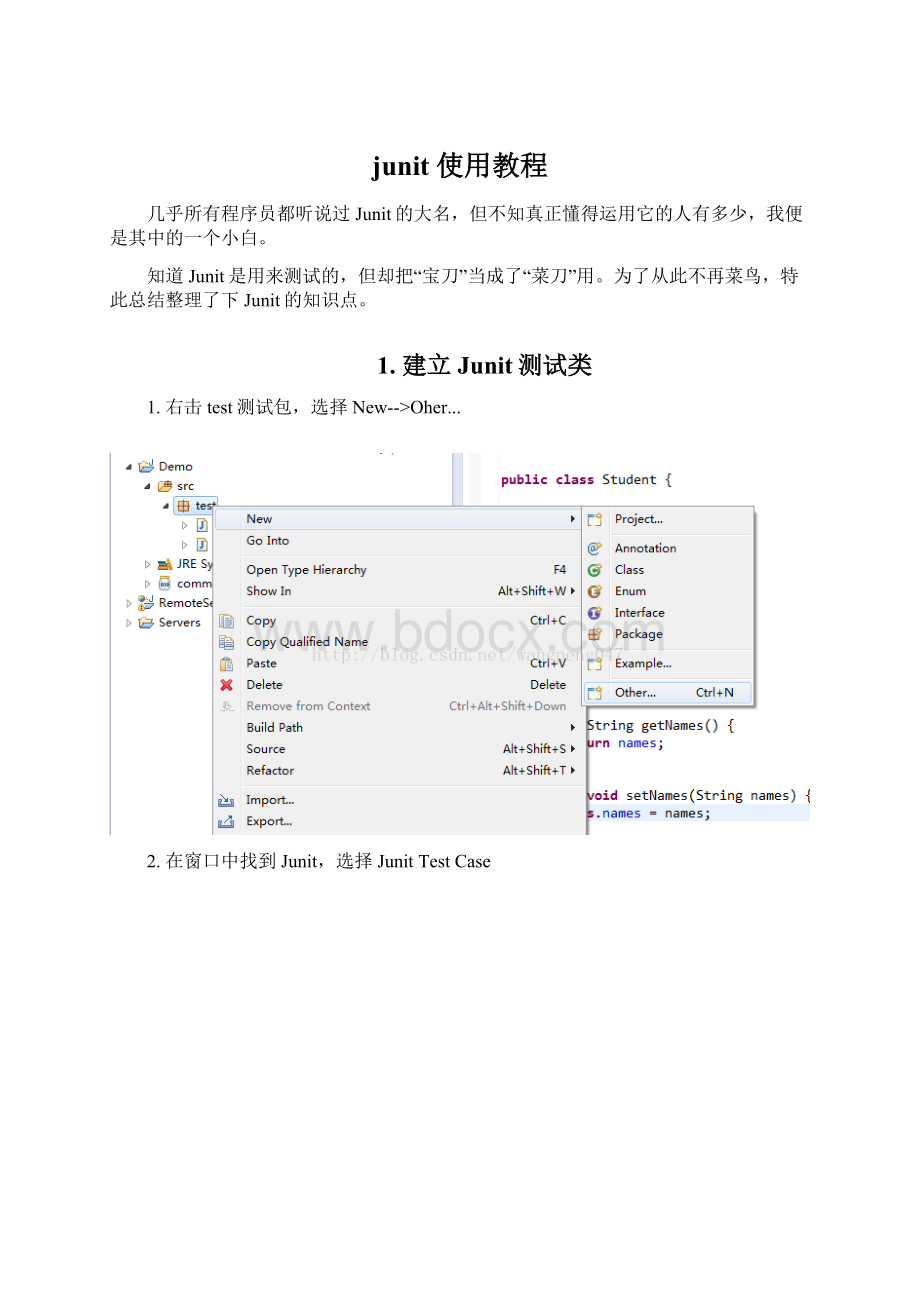junit 使用教程.docx
《junit 使用教程.docx》由会员分享,可在线阅读,更多相关《junit 使用教程.docx(40页珍藏版)》请在冰豆网上搜索。

junit使用教程
几乎所有程序员都听说过Junit的大名,但不知真正懂得运用它的人有多少,我便是其中的一个小白。
知道Junit是用来测试的,但却把“宝刀”当成了“菜刀”用。
为了从此不再菜鸟,特此总结整理了下Junit的知识点。
1.建立Junit测试类
1.右击test测试包,选择New-->Oher...
2.在窗口中找到Junit,选择JunitTestCase
3.输入名称(Name),命名规则一般建议采用:
类名+Test。
Browse...选择要测试的类,这里是StudentService。
4.勾选要测试的方法
5.生成后,效果如下:
这里importstatic是引入Assert类中静态属性或静态方法的写法。
原来要Assert.fail(),现在只需直接fial()即可,即省略了Assert。
其实不通过Junit新建向导来建立也可以,随便建立一个新类后,只需在方法上加入@Test注解即可。
2.核心——断言
断言是编写测试用例的核心实现方式,即期望值是多少,测试的结果是多少,以此来判断测试是否通过。
1.断言核心方法
assertArrayEquals(expecteds,actuals)
查看两个数组是否相等。
assertEquals(expected,actual)
查看两个对象是否相等。
类似于字符串比较使用的equals()方法
assertNotEquals(first,second)
查看两个对象是否不相等。
assertNull(object)
查看对象是否为空。
assertNotNull(object)
查看对象是否不为空。
assertSame(expected,actual)
查看两个对象的引用是否相等。
类似于使用“==”比较两个对象
assertNotSame(unexpected,actual)
查看两个对象的引用是否不相等。
类似于使用“!
=”比较两个对象
assertTrue(condition)
查看运行结果是否为true。
assertFalse(condition)
查看运行结果是否为false。
assertThat(actual,matcher)
查看实际值是否满足指定的条件
fail()
让测试失败
2.示例
[java]viewplaincopyprint?
package test;
import static org.hamcrest.CoreMatchers.*;
import static org.junit.Assert.*;
import java.util.Arrays;
import org.hamcrest.core.CombinableMatcher;
import org.junit.Test;
public class AssertTests {
@Test
public void testAssertArrayEquals() {
byte[] expected = "trial".getBytes();
byte[] actual = "trial".getBytes();
org.junit.Assert.assertArrayEquals("failure - byte arrays not same", expected, actual);
}
@Test
public void testAssertEquals() {
org.junit.Assert.assertEquals("failure - strings not same", 5l, 5l);
}
@Test
public void testAssertFalse() {
org.junit.Assert.assertFalse("failure - should be false", false);
}
@Test
public void testAssertNotNull() {
org.junit.Assert.assertNotNull("should not be null", new Object());
}
@Test
public void testAssertNotSame() {
org.junit.Assert.assertNotSame("should not be same Object", new Object(), new Object());
}
@Test
public void testAssertNull() {
org.junit.Assert.assertNull("should be null", null);
}
@Test
public void testAssertSame() {
Integer aNumber = Integer.valueOf(768);
org.junit.Assert.assertSame("should be same", aNumber, aNumber);
}
// JUnit Matchers assertThat
@Test
public void testAssertThatBothContainsString() {
org.junit.Assert.assertThat("albumen", both(containsString("a")).and(containsString("b")));
}
@Test
public void testAssertThathasItemsContainsString() {
org.junit.Assert.assertThat(Arrays.asList("one", "two", "three"), hasItems("one", "three"));
}
@Test
public void testAssertThatEveryItemContainsString() {
org.junit.Assert.assertThat(Arrays.asList(new String[] { "fun", "ban", "net" }), everyItem(containsString("n")));
}
// Core Hamcrest Matchers with assertThat
@Test
public void testAssertThatHamcrestCoreMatchers() {
assertThat("good", allOf(equalTo("good"), startsWith("good")));
assertThat("good", not(allOf(equalTo("bad"), equalTo("good"))));
assertThat("good", anyOf(equalTo("bad"), equalTo("good")));
assertThat(7, not(CombinableMatcher. either(equalTo(3)).or(equalTo(4))));
assertThat(new Object(), not(sameInstance(new Object())));
}
}
packagetest;
importstaticorg.hamcrest.CoreMatchers.*;
importstaticorg.junit.Assert.*;
importjava.util.Arrays;
importorg.hamcrest.core.CombinableMatcher;
importorg.junit.Test;
publicclassAssertTests{
@Test
publicvoidtestAssertArrayEquals(){
byte[]expected="trial".getBytes();
byte[]actual="trial".getBytes();
org.junit.Assert.assertArrayEquals("failure-bytearraysnotsame",expected,actual);
}
@Test
publicvoidtestAssertEquals(){
org.junit.Assert.assertEquals("failure-stringsnotsame",5l,5l);
}
@Test
publicvoidtestAssertFalse(){
org.junit.Assert.assertFalse("failure-shouldbefalse",false);
}
@Test
publicvoidtestAssertNotNull(){
org.junit.Assert.assertNotNull("shouldnotbenull",newObject());
}
@Test
publicvoidtestAssertNotSame(){
org.junit.Assert.assertNotSame("shouldnotbesameObject",newObject(),newObject());
}
@Test
publicvoidtestAssertNull(){
org.junit.Assert.assertNull("shouldbenull",null);
}
@Test
publicvoidtestAssertSame(){
IntegeraNumber=Integer.valueOf(768);
org.junit.Assert.assertSame("shouldbesame",aNumber,aNumber);
}
//JUnitMatchersassertThat
@Test
publicvoidtestAssertThatBothContainsString(){
org.junit.Assert.assertThat("albumen",both(containsString("a")).and(containsString("b")));
}
@Test
publicvoidtestAssertThathasItemsContainsString(){
org.junit.Assert.assertThat(Arrays.asList("one","two","three"),hasItems("one","three"));
}
@Test
publicvoidtestAssertThatEveryItemContainsString(){
org.junit.Assert.assertThat(Arrays.asList(newString[]{"fun","ban","net"}),everyItem(containsString("n")));
}
//CoreHamcrestMatcherswithassertThat
@Test
publicvoidtestAssertThatHamcrestCoreMatchers(){
assertThat("good",allOf(equalTo("good"),startsWith("good")));
assertThat("good",not(allOf(equalTo("bad"),equalTo("good"))));
assertThat("good",anyOf(equalTo("bad"),equalTo("good")));
assertThat(7,not(CombinableMatcher.either(equalTo(3)).or(equalTo(4))));
assertThat(newObject(),not(sameInstance(newObject())));
}
}
3.核心——注解
3.1.说明
@Before
初始化方法
@After
释放资源
@Test
测试方法,在这里可以测试期望异常和超时时间
@Ignore
忽略的测试方法
@BeforeClass
针对所有测试,只执行一次,且必须为staticvoid
@AfterClass
针对所有测试,只执行一次,且必须为staticvoid
@RunWith
指定测试类使用某个运行器
@Parameters
指定测试类的测试数据集合
@Rule
允许灵活添加或重新定义测试类中的每个测试方法的行为
@FixMethodOrder
指定测试方法的执行顺序
3.2.执行顺序
一个测试类单元测试的执行顺序为:
@BeforeClass–>@Before–>@Test–>@After–>@AfterClass
每一个测试方法的调用顺序为:
@Before–>@Test–>@After
3.3.示例
[java]viewplaincopyprint?
package test;
import static org.junit.Assert.*;
import org.junit.*;
public class JDemoTest {
@BeforeClass
public static void setUpBeforeClass() throws Exception {
System.out.println("in BeforeClass================");
}
@AfterClass
public static void tearDownAfterClass() throws Exception {
System.out.println("in AfterClass=================");
}
@Before
public void before() {
System.out.println("in Before");
}
@After
public void after() {
System.out.println("in After");
}
@Test(timeout = 10000)
public void testadd() {
JDemo a = new JDemo();
assertEquals(6, a.add(3, 3));
System.out.println("in Test ----Add");
}
@Test
public void testdivision() {
JDemo a = new JDemo();
assertEquals(3, a.division(6, 2));
System.out.println("in Test ----Division");
}
@Ignore
@Test
public void test_ignore() {
JDemo a = new JDemo();
assertEquals(6, a.add(1, 5));
System.out.println("in test_ignore");
}
@Test
public void teest_fail() {
fail();
}
}
class JDemo extends Thread {
int result;
public int add(int a, int b) {
try {
sleep(1000);
result = a + b;
} catch (InterruptedException e) {
}
return result;
}
public int division(int a, int b) {
return result = a / b;
}
}
packagetest;
importstaticorg.junit.Assert.*;
importorg.junit.*;
publicclassJDemoTest{
@BeforeClass
publicstaticvoidsetUpBeforeClass()throwsException{
System.out.println("inBeforeClass================");
}
@AfterClass
publicstaticvoidtearDownAfterClass()throwsException{
System.out.println("inAfterClass=================");
}
@Before
publicvoidbefore(){
System.out.println("inBefore");
}
@After
publicvoidafter(){
System.out.println("inAfter");
}
@Test(timeout=10000)
publicvoidtestadd(){
JDemoa=newJDemo();
assertEquals(6,a.add(3,3));
System.out.println("inTest----Add");
}
@Test
publicvoidtestdivision(){
JDemoa=newJDemo();
assertEquals(3,a.division(6,2));
System.out.println("inTest----Division");
}
@Ignore
@Test
publicvoidtest_ignore(){
JDemoa=newJDemo();
assertEquals(6,a.add(1,5));
System.out.println("intest_ignore");
}
@Test
publicvoidteest_fail(){
fail();
}
}
classJDemoextendsThread{
intresult;
publicintadd(inta,intb){
try{
sleep(1000);
result=a+b;
}catch(InterruptedExceptione){
}
returnresult;
}
publicintdivision(inta,intb){
returnresult=a/b;
}
}
执行结果:
[plain]viewplaincopyprint?
in BeforeClass================
in Before
in Test ----Add
in After
in Before
in Test ----Division
in After
in AfterClass=================
inBeforeClass================
inBefore
inTest----Add
inAfter
inBefore
inTest----Division
inAfter
inAfterClass=================
图中左上红框中部分表示Junit运行结果,5个成功(1个忽略),1个错误,1个失败。
(注意错误和失败不是一回事,错误说明代码有错误,而失败表示该测试方法测试失败)
左下红框中则表示出了各个测试方法的运行状态,可以看到成功、错误、失败、失败各自的图标是不一样的,还可以看到运行时间。
右边部分则是异常堆栈,可查看异常信息。
3.4.实例总结
3.4.1.参数化测试
有时一个测试方法,不同的参数值会产生不同的结果,那么我们为了测试全面,会把多个参数值都写出来并一一断言测试,这样有时难免费时费力,这是我们便可以采用参数化测试来解决这个问题。
参数化测试就好比把一个“输入值,期望值”的集合传入给测试方法,达到一次性